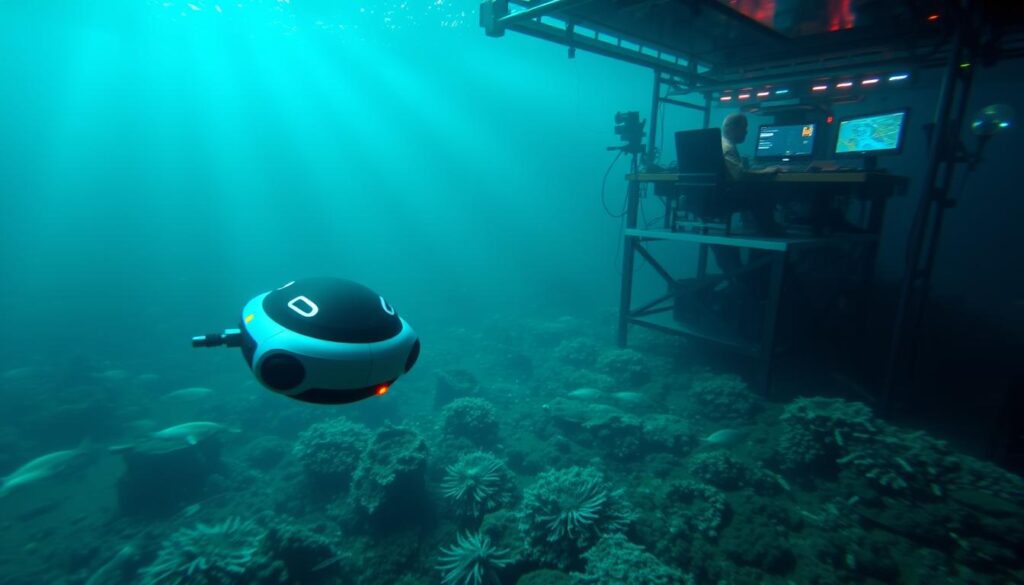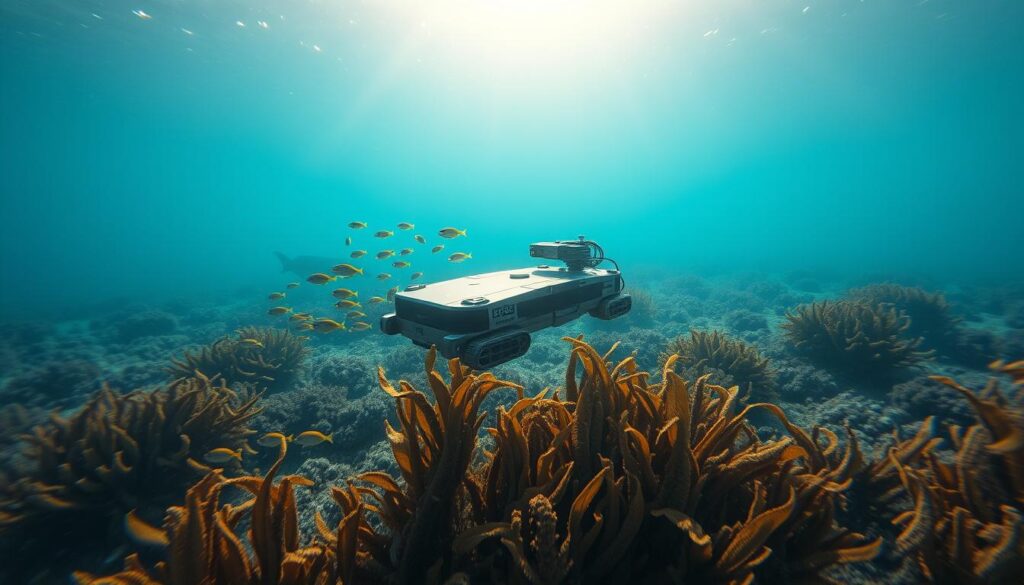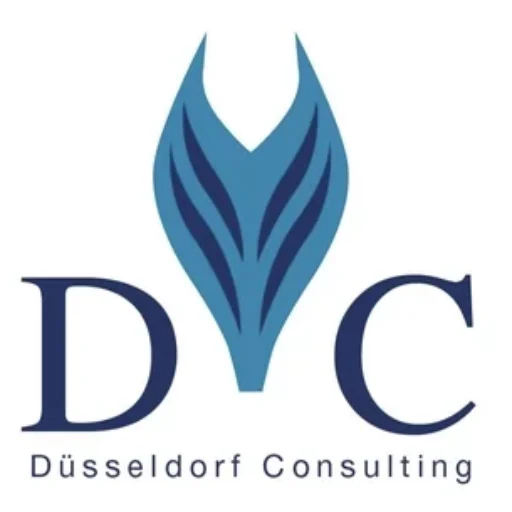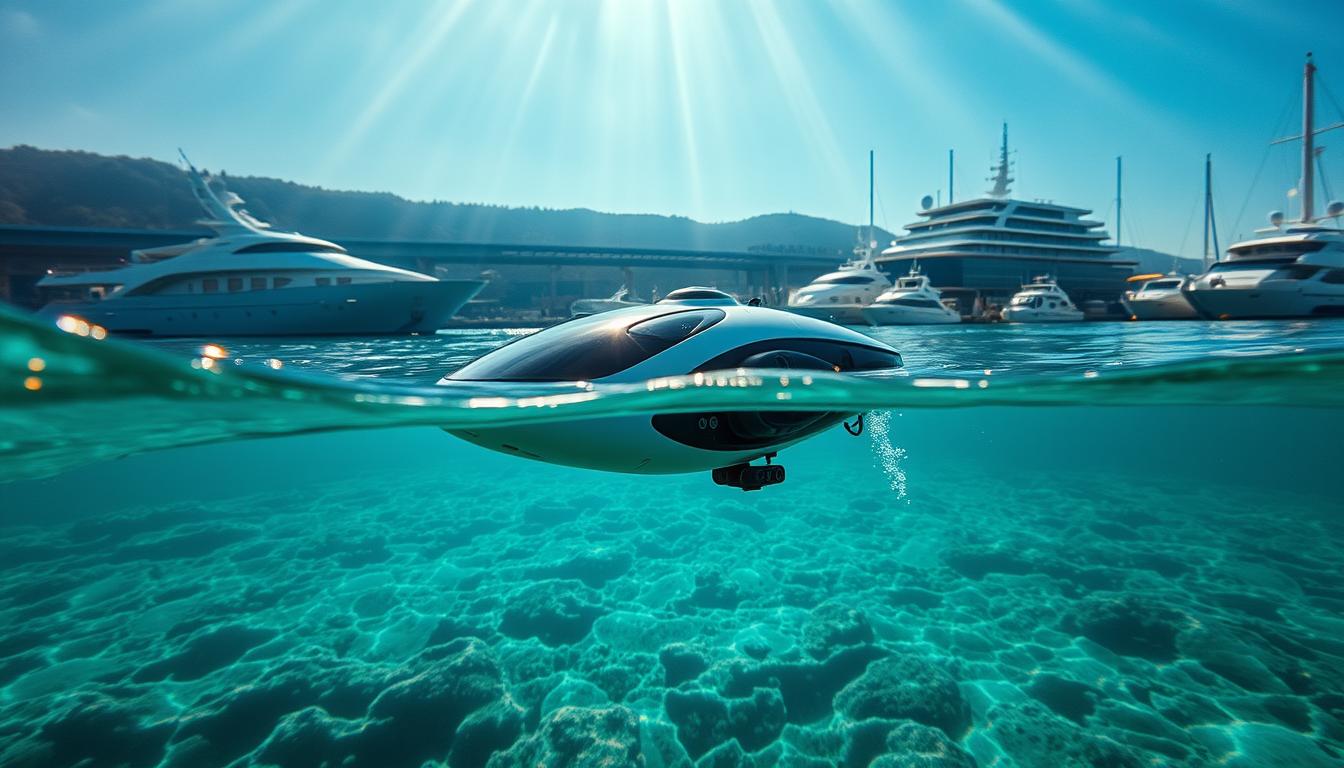The ocean, covering over 70% of our planet, is home to 80% of life on Earth. As pollution, overfishing, and climate change continue to threaten marine ecosystems, innovative solutions are emerging to help mitigate this damage.
Germany is at the forefront of this innovation, with marine technology startups developing cutting-edge underwater robotics and seafloor mapping technologies. These advancements are crucial for understanding and protecting our oceans.
Key Takeaways
- Germany is a hub for marine technology innovation.
- Underwater robotics and seafloor mapping are key areas of focus.
- Startups are driving technological advancements.
- These technologies help protect marine ecosystems.
- Innovative solutions are crucial for the future of our oceans.
Overview of Underwater Robotics in Germany
The German underwater robotics industry is thriving, with companies like PlanBlue leading the way. PlanBlue has developed an innovative “underwater satellite” called DiveRay, which utilizes high-resolution cameras and navigation sensors to map the seafloor. This technology is a significant advancement in underwater robotics, enabling the creation of detailed, interactive maps of the seafloor.
Key Technologies in Underwater Robotics
Underwater robotics in Germany is driven by several key technologies. These include advanced sonar systems, high-resolution cameras, and sophisticated navigation sensors. Companies are also leveraging Artificial Intelligence (AI) to process the vast amounts of data collected during underwater missions.
The integration of AI algorithms allows for the creation of detailed maps and models of the seafloor, enhancing our understanding of marine ecosystems. For instance, PlanBlue’s DiveRay uses AI to analyze data from its high-resolution cameras and navigation sensors, producing interactive maps that can be used for various applications.
| Technology | Description | Application |
|---|---|---|
| Advanced Sonar Systems | Utilize sound waves to map the seafloor | Seafloor mapping, object detection |
| High-Resolution Cameras | Capture detailed images of the seafloor | Marine life observation, habitat mapping |
| Navigation Sensors | Enable precise positioning and tracking underwater | Underwater exploration, mapping |
Application Areas of Underwater Robotics
Underwater robotics has a wide range of applications in Germany, including marine research, environmental monitoring, and offshore industry inspections. The technology is used to inspect underwater infrastructure, monitor marine life, and explore new areas of the seafloor.
German underwater drone companies are at the forefront of these applications, providing innovative solutions that are both efficient and cost-effective. For example, underwater drones equipped with high-resolution cameras can be used to monitor marine life and track changes in marine ecosystems.
Benefits of Underwater Robotics for Marine Research
The use of underwater robotics in marine research has several benefits. It allows scientists to explore and study areas of the seafloor that were previously inaccessible. The technology also enables the collection of high-quality data, which can be used to inform conservation efforts and improve our understanding of marine ecosystems.
By leveraging underwater robotics, researchers can gain insights into marine life and habitats, track changes in the seafloor, and identify areas that require conservation. This information is crucial for developing effective conservation strategies and managing marine resources sustainably.
The Importance of Seafloor Mapping
Accurate seafloor mapping is essential for a variety of applications, from environmental monitoring to industrial operations. The process involves creating detailed maps of the seafloor, which are crucial for understanding the complexities of underwater ecosystems.
Overview of Seafloor Mapping Techniques
Seafloor mapping employs several advanced technologies to gather data about the ocean floor. Techniques such as multibeam sonar and hyperspectral imaging are being utilized to create detailed maps.
Multibeam sonar, for instance, uses sound waves to map the seafloor’s topography, providing high-resolution data on depth and terrain. Hyperspectral imaging, on the other hand, captures detailed spectral information, helping to identify different materials and features on the seafloor.
“The use of hyperspectral imaging in seafloor mapping has revolutionized our ability to analyze the chemical and biological composition of the ocean floor.”
Applications of Seafloor Mapping in Industry
Seafloor mapping has numerous applications across various industries. Some of the key areas include:
- Offshore oil and gas exploration
- Cable laying and pipeline routing
- Mineral exploration
- Marine construction
These applications rely on accurate seafloor maps to ensure safe and efficient operations.
| Industry | Application | Benefit of Seafloor Mapping |
|---|---|---|
| Offshore Oil and Gas | Exploration and extraction | Accurate site assessment |
| Cable and Pipeline | Routing and laying | Route optimization |
| Mineral Exploration | Resource identification | Targeted exploration |
Environmental Monitoring and Seafloor Mapping
Seafloor mapping plays a critical role in environmental monitoring. By tracking changes in the seafloor, researchers can monitor the health of marine ecosystems.
For example, changes in seafloor topography can indicate erosion or sedimentation patterns, which are vital for understanding the impacts of climate change.
Germany’s startups in underwater robotics and seafloor mapping are at the forefront of these innovations, contributing significantly to both industrial applications and environmental conservation.
Leading Startups in Underwater Robotics
Germany’s underwater robotics industry is gaining momentum, with notable startups emerging and attracting investment from programs like Climate KIC. This growth is driven by innovations in robotics and seafloor mapping technologies.
Notable Companies and Their Innovations
Several startups are making significant contributions to the field of underwater robotics. For instance, PlanBlue is a company based in Germany that is using advanced technologies for marine conservation and research. Their innovations include detailed seafloor mapping and underwater inspection services.
Other notable companies are also pushing the boundaries in underwater robotics. Some of the key innovations include:
- Advanced sensor technologies for underwater exploration
- Autonomous underwater vehicles (AUVs) for seafloor mapping
- Remotely operated vehicles (ROVs) for underwater inspection and maintenance

Funding and Investment Trends in the Sector
The underwater robotics sector is attracting significant investment, with various funding programs supporting startups. For example, Climate KIC is a major driver of innovation, providing financial support to companies like PlanBlue.
Some of the key trends in funding and investment include:
- Increased focus on sustainable technologies
- Growing investment in autonomous underwater vehicles
- Rising demand for seafloor mapping services driving investment in related technologies
As stated by a representative from Climate KIC, “The future of underwater robotics is bright, with significant potential for growth and innovation in the sector.” This sentiment is echoed by industry experts who see a promising future for underwater robotics in Germany.
Promising Startups in Seafloor Mapping
Startups in Germany are making significant strides in seafloor mapping, enhancing our understanding of the ocean floor. This section highlights the companies that are revolutionizing seafloor mapping and the technologies they are developing.
Companies Revolutionizing Seafloor Mapping
Companies like PlanBlue are at the forefront of seafloor mapping innovations in Germany. PlanBlue has teamed up with Dutch surveying giant Fugro to scale up its technology. Their DiveRay technology is being made compatible with underwater robots, marking a significant advancement in the field.
This collaboration is expected to enhance the precision and efficiency of seafloor mapping, contributing to various industries such as offshore energy and environmental monitoring.
Technology Development and Collaboration
The development of seafloor mapping technology is being driven by collaborations between startups and established companies. For instance, PlanBlue’s partnership with Fugro is a testament to the potential of such collaborations. These partnerships are not only enhancing the technology but also expanding its applications.
| Startup | Innovation | Collaboration |
|---|---|---|
| PlanBlue | DiveRay Technology | Fugro |
| Other Startup | Advanced Mapping Software | Research Institutions |
These collaborations are crucial for the growth of the ocean technology sector in Germany, fostering innovation and the development of cutting-edge technologies.
Challenges Facing Underwater Robotics Startups
The burgeoning field of underwater robotics in Germany is not without its obstacles, as startups navigate through technological limitations, regulatory frameworks, and environmental issues. Despite the innovative nature of their work, these companies face significant hurdles that can impact their growth and success.
Technological Barriers and Solutions
One of the primary challenges facing underwater robotics startups is the technological barrier. Developing robust, reliable, and efficient underwater systems requires significant advancements in materials science, robotics, and sensor technology. For instance, underwater robots must be able to withstand corrosive marine environments, operate under high pressure, and maintain precise navigation and communication.
Technological innovations such as advanced materials and AI-driven navigation systems are being developed to address these challenges. Companies are investing heavily in research and development to create more sophisticated underwater robots that can efficiently map the seafloor, inspect underwater infrastructure, and monitor marine life.
Regulatory and Environmental Challenges
In addition to technological barriers, underwater robotics startups must also navigate complex regulatory frameworks. These regulations are designed to protect marine environments and ensure that underwater activities do not harm ecosystems. Compliance with these regulations can be challenging, particularly for startups with limited resources.
Environmental concerns are another significant challenge. Underwater robotics operations must be designed to minimize their impact on marine ecosystems. This includes avoiding disturbance to marine life, preventing pollution, and ensuring that underwater robots do not damage sensitive habitats. Startups are adopting sustainable practices and developing technologies that support environmental monitoring and conservation.
The interplay between technological innovation, regulatory compliance, and environmental stewardship is crucial for the success of underwater robotics startups in Germany. By addressing these challenges, companies can not only achieve their business goals but also contribute to the sustainable development of marine resources.
Market Trends in Underwater Robotics
As concern for the world’s oceans grows, Germany’s underwater robotics market is poised for substantial growth, driven by innovation and technological advancements. The increasing demand for sustainable solutions to protect marine ecosystems is a significant driver for this growth.
Growth Drivers for Underwater Robotics in Germany
Several factors are driving the growth of underwater robotics in Germany. Innovative technologies and investments in research and development are key contributors. The need for efficient and effective solutions for ocean exploration and protection is pushing the demand for underwater robotics.
- Increasing investments in marine technology
- Growing demand for sustainable ocean solutions
- Advancements in robotics and AI technologies
- Government initiatives supporting marine tech startups
The table below highlights the key growth drivers and their impact on the underwater robotics market in Germany.
| Growth Driver | Impact on Market |
|---|---|
| Increasing Investments | Boosts innovation and development of new technologies |
| Growing Demand for Sustainability | Drives demand for underwater robotics solutions |
| Technological Advancements | Enhances efficiency and effectiveness of underwater robotics |
Future Projections and Market Potential
The future of underwater robotics in Germany looks promising, with significant potential for growth. As technology continues to evolve, we can expect to see more sophisticated and capable underwater robots being developed.

The market is expected to expand into new areas, including environmental monitoring and offshore infrastructure inspection. With the right support and investment, Germany’s underwater robotics startups are well-positioned to lead the way in this exciting and rapidly evolving field.
The Role of Research Institutions
Germany’s research institutions are pivotal in the development of underwater robotics and seafloor mapping. These institutions are not only advancing the technological capabilities of these fields but also fostering a collaborative environment between academia and industry.
The collaboration between startups and research institutions is a key driver of innovation. For instance, the University of Hamburg has been working closely with robotics companies, including those specializing in underwater robotics, to develop new technologies and applications. This partnership enables the translation of cutting-edge research into practical solutions.
Collaboration Between Startups and Academia
The synergy between startups and academic institutions is crucial for the advancement of underwater robotics. Research institutions provide access to state-of-the-art facilities and expertise, while startups bring industry insights and entrepreneurial spirit. This collaboration is exemplified by initiatives such as the German Research Foundation’s funding programs that support joint research projects between academia and industry.
“The partnership between academia and startups is essential for driving innovation in underwater robotics. It allows for the development of novel technologies that can be commercialized and applied in real-world scenarios.”
Impact of Research on Innovation
The impact of research conducted by German institutions on the innovation landscape of underwater robotics and seafloor mapping is significant. Research in areas such as autonomous underwater vehicles (AUVs) and advanced sonar technologies has led to the development of more efficient and capable systems.
| Research Area | Innovation Impact | Beneficiary |
|---|---|---|
| AUVs | Enhanced autonomy and navigation | Underwater inspection and survey companies |
| Advanced Sonar | Improved seafloor mapping accuracy | Offshore construction and environmental monitoring agencies |
As research institutions continue to push the boundaries of what is possible in underwater robotics and seafloor mapping, the potential for new applications and innovations grows. The ongoing collaboration between academia and industry is set to remain a driving force behind these advancements.
Government Support for Underwater Robotics
The German government’s support for underwater robotics is paving the way for advancements in ocean technology. This support is multifaceted, involving both policy initiatives and funding programs designed to foster innovation and growth in the sector.
Policies Encouraging Innovation in Marine Tech
The German government has introduced several policies aimed at encouraging innovation in marine technology, including underwater robotics. These policies create a favorable environment for startups by providing them with the necessary regulatory support and incentives to develop new technologies.
Key policy initiatives include:
- Streamlined regulatory processes for obtaining permits and approvals
- Tax incentives for research and development in marine tech
- Support for collaborative research projects between industry and academia
Funding Programs for Startups
In addition to policy support, the German government offers various funding programs specifically designed for startups in the underwater robotics sector. These programs provide financial assistance to help startups overcome the challenges associated with developing and commercializing new technologies.
Notable funding programs include:
- The German Aerospace Center’s (DLR) funding initiatives for innovative technologies
- The Federal Ministry for Economic Affairs and Energy’s (BMWi) programs supporting startups in the marine tech sector
By combining policy support with financial funding, the German government is creating a comprehensive ecosystem that supports the growth and development of underwater robotics startups. This support is crucial for driving innovation and ensuring that German companies remain competitive in the global market.
Future Outlook for Underwater Robotics and Seafloor Mapping
The future of underwater robotics and seafloor mapping in Germany is poised for significant advancements, driven by innovative marine robotics companies and ocean technology startups, particularly in Berlin.
Advancements on the Horizon
Emerging technologies like AI and hyperspectral imaging are set to revolutionize the field. These technologies will enhance the capabilities of underwater robotics, enabling more precise and efficient seafloor mapping.
Transforming Ocean Exploration
Underwater Robotics and Seafloor Mapping Startups in Germany are at the forefront of this transformation. With continued support from government initiatives and research institutions, these startups are likely to drive significant breakthroughs in ocean exploration.
As these technologies mature, we can expect a deeper understanding of the world’s oceans, with far-reaching implications for environmental conservation, resource management, and scientific research.
FAQ
What is the current state of underwater robotics in Germany?
Germany is home to a thriving underwater robotics industry, with companies like PlanBlue developing innovative solutions for marine research and exploration. The country is leveraging advancements in robotics, artificial intelligence, and sensor technology to improve our understanding of the oceans.
What are the key technologies being developed in underwater robotics?
Key technologies in underwater robotics include autonomous underwater vehicles (AUVs), remotely operated vehicles (ROVs), and advanced sensor systems. These technologies enable the collection of high-resolution data on ocean currents, water quality, and marine life.
How is seafloor mapping being used in industry?
Seafloor mapping is being used in various industries, including offshore energy, shipping, and fisheries management. Accurate seafloor maps help companies identify potential hazards, optimize operations, and reduce environmental impact.
What are the challenges facing underwater robotics startups in Germany?
Underwater robotics startups in Germany face technological barriers, regulatory challenges, and environmental concerns. They must navigate complex regulatory frameworks, address environmental concerns, and overcome technological hurdles to bring their innovations to market.
What is the role of research institutions in driving innovation in underwater robotics?
Research institutions play a crucial role in driving innovation in underwater robotics by collaborating with startups, developing new technologies, and providing access to expertise and resources. This collaboration helps to accelerate the development of new technologies and their adoption in industry.
What government support is available for underwater robotics startups in Germany?
The German government offers various funding programs and policies to support innovation in marine technology, including underwater robotics. These initiatives provide financial support, tax incentives, and other resources to help startups overcome the challenges they face.
What are the emerging technologies on the horizon for underwater robotics and seafloor mapping?
Emerging technologies in underwater robotics and seafloor mapping include advanced AUVs, swarm robotics, and machine learning algorithms. These technologies have the potential to revolutionize our understanding of the oceans and improve our ability to manage marine resources sustainably.
What is the future outlook for underwater robotics and seafloor mapping in Germany?
The future outlook for underwater robotics and seafloor mapping in Germany is promising, with significant growth potential and opportunities for innovation. As the industry continues to evolve, we can expect to see new technologies and applications emerge, driving further advancements in our understanding of the oceans.
How are startups in Germany contributing to the development of seafloor mapping technologies?
Startups in Germany are revolutionizing seafloor mapping by developing innovative technologies, such as advanced sonar systems and data analytics platforms. These companies are collaborating with industry partners, research institutions, and government agencies to drive innovation and improve our understanding of the seafloor.




